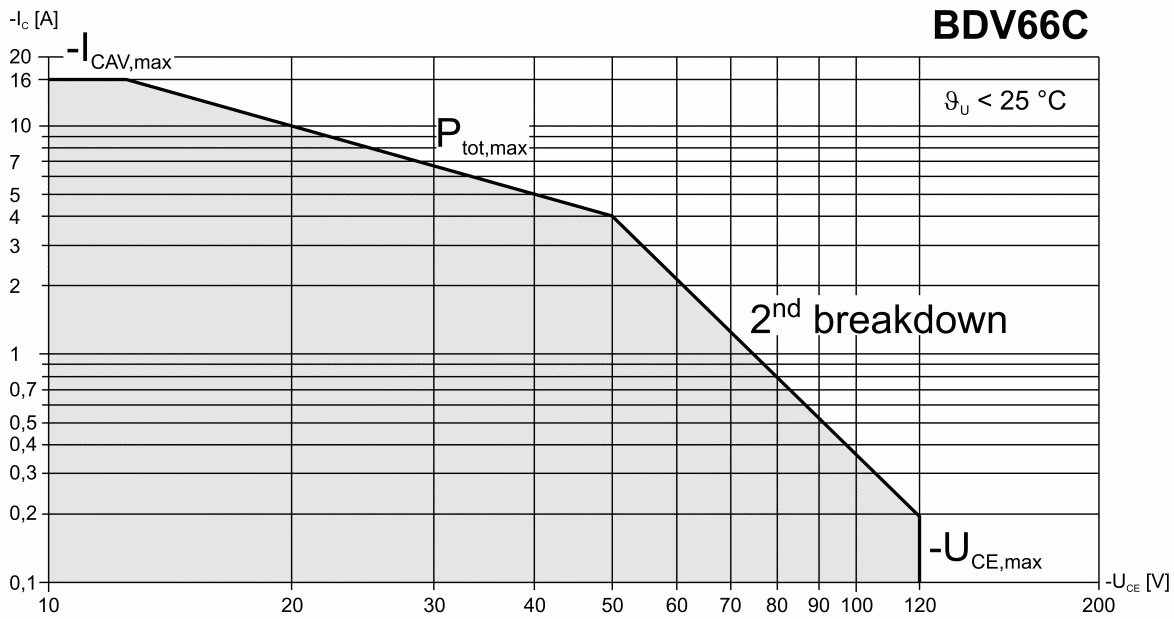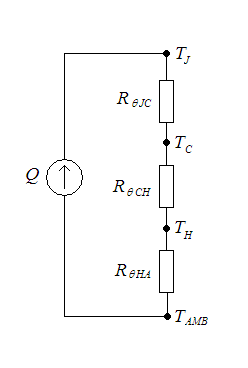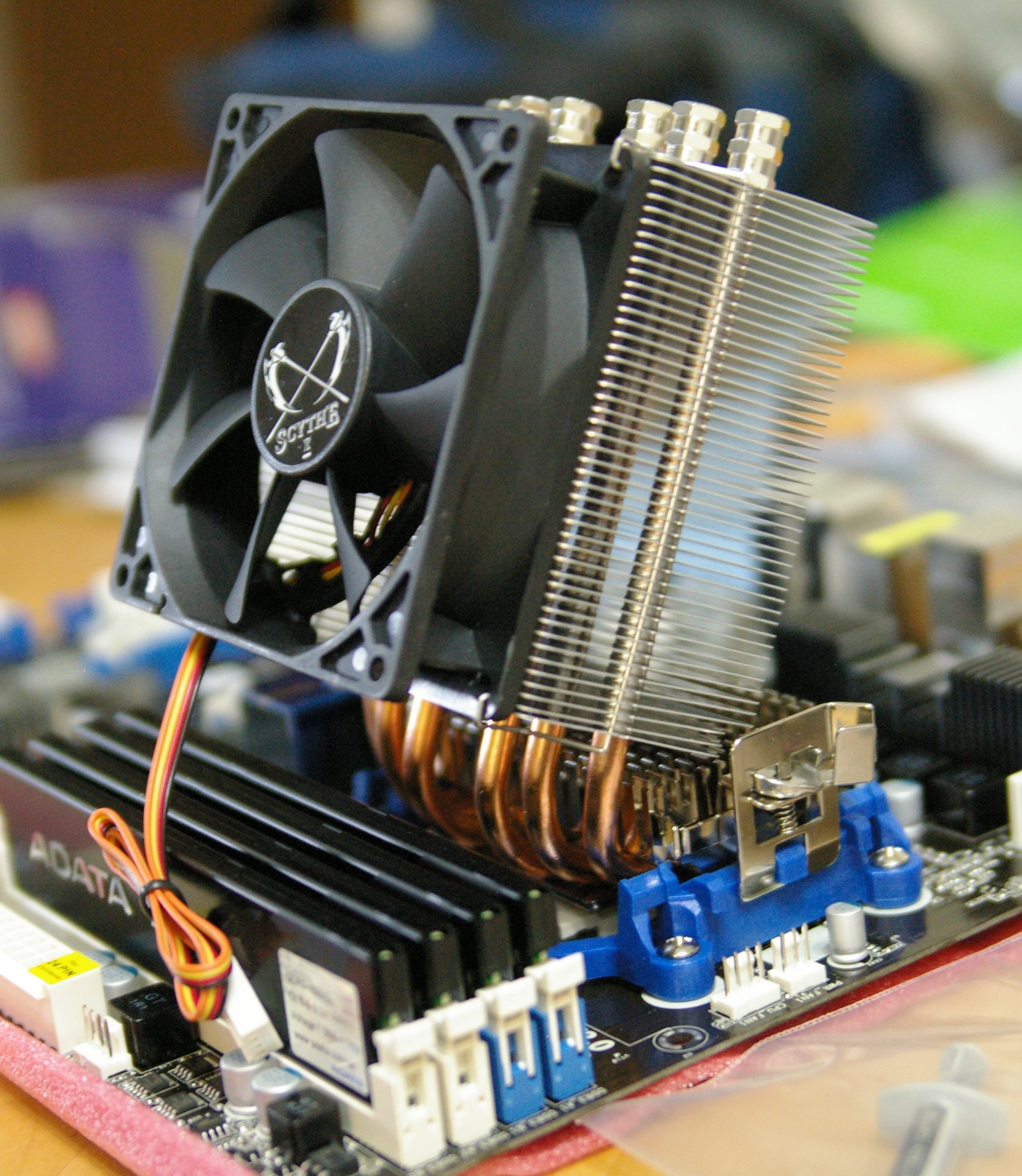|
Derating
In electronics, derating is the operation of a device at less than its rated maximum capability to prolong its life. Typical examples include operations below the maximum power rating, current rating, or voltage rating. In electronics Power semiconductor devices have a maximum power dissipation rating usually quoted at a case temperature of . The datasheet for the device also includes a ''derating curve'' which indicates how much a device will dissipate without getting damaged at any given case temperature, and this must be taken into account while designing a system. As can be seen from the derating curve image for a hypothetical bipolar junction transistor, the device (rated for 100 W at ) cannot be expected to dissipate anything more than about 40 W if the ambient temperature is such that the temperature at which the device's case will stabilize (after heat-sinking) is . This final case temperature is a function of the thermal resistance between the device's case and the ... [...More Info...] [...Related Items...] OR: [Wikipedia] [Google] [Baidu] |
Dimmer
A dimmer is a device connected to a light fixture and used to lower the brightness of the Lighting, light. By changing the voltage waveform applied to the lamp, it is possible to lower the Luminous intensity, intensity of the light output. Although variable-voltage devices are used for various purposes, the term ''dimmer'' is generally reserved for those intended to lighting control system, control light output from resistive Incandescent light, incandescent, Halogen lamp, halogen, and (more recently) compact fluorescent lamps (CFLs) and light-emitting diodes (LED lamp, LEDs). More specialized equipment is needed to dim Fluorescent lamp, fluorescent, Mercury-vapor lamp, mercury-vapor, Solid-state lighting, solid-state, and other Arc lamp, arc lighting. Dimmers range in size from small units the size of domestic light switches to high-power units used in large theatrical or architectural lighting design, architectural lighting installations. Small domestic dimmers are generally ... [...More Info...] [...Related Items...] OR: [Wikipedia] [Google] [Baidu] |
Safe Operating Area
For power semiconductor devices (such as BJT, MOSFET, thyristor or IGBT), the safe operating area (SOA) is defined as the voltage and current (electricity), current conditions over which the device can be expected to operate without self-damage. SOA is usually presented in transistor datasheets as a graph with VCE (collector-emitter voltage) on the abscissa and ICE (collector-emitter current) on the ordinate; the safe 'area' referring to the area under the curve. The SOA specification combines the various limitations of the device — maximum voltage, current, power, junction temperature, secondary breakdown — into one curve, allowing simplified design of protection circuitry. Often, in addition to the continuous rating, separate SOA curves are also plotted for short duration pulse conditions (1 ms pulse, 10 ms pulse, etc.). The safe operating area curve is a graphical representation of the power handling capability of the device under various conditions. The SOA curve takes in ... [...More Info...] [...Related Items...] OR: [Wikipedia] [Google] [Baidu] |
Electronic Device
Electronics is a scientific and engineering discipline that studies and applies the principles of physics to design, create, and operate devices that manipulate electrons and other electrically charged particles. It is a subfield of physics and electrical engineering which uses active devices such as transistors, diodes, and integrated circuits to control and amplify the flow of electric current and to convert it from one form to another, such as from alternating current (AC) to direct current (DC) or from analog signals to digital signals. Electronic devices have significantly influenced the development of many aspects of modern society, such as telecommunications, entertainment, education, health care, industry, and security. The main driving force behind the advancement of electronics is the semiconductor industry, which continually produces ever-more sophisticated electronic devices and circuits in response to global demand. The semiconductor industry is one of the gl ... [...More Info...] [...Related Items...] OR: [Wikipedia] [Google] [Baidu] |
Bipolar Junction Transistor
A bipolar junction transistor (BJT) is a type of transistor that uses both electrons and electron holes as charge carriers. In contrast, a unipolar transistor, such as a field-effect transistor (FET), uses only one kind of charge carrier. A bipolar transistor allows a small current injected at one of its terminals to control a much larger current between the remaining two terminals, making the device capable of amplification or switching. BJTs use two p–n junctions between two semiconductor types, n-type and p-type, which are regions in a single crystal of material. The junctions can be made in several different ways, such as changing the doping of the semiconductor material as it is grown, by depositing metal pellets to form alloy junctions, or by such methods as diffusion of n-type and p-type doping substances into the crystal. The superior predictability and performance of junction transistors quickly displaced the original point-contact transistor. Diffused trans ... [...More Info...] [...Related Items...] OR: [Wikipedia] [Google] [Baidu] |
Heat Sink
A heat sink (also commonly spelled heatsink) is a passive heat exchanger that transfers the heat generated by an electronic or a mechanical device to a fluid medium, often air or a liquid coolant, where it is thermal management (electronics), dissipated away from the device, thereby allowing regulation of the device's temperature. In computers, heat sinks computer cooling, are used to cool central processing unit, CPUs, graphics processing unit, GPUs, and some chipsets and RAM modules. Heat sinks are used with other high-power semiconductor devices such as Transistor#Other transistor types, power transistors and optoelectronics such as lasers and light-emitting diodes (LEDs), where the heat dissipation ability of the component itself is insufficient to moderate its temperature. A heat sink is designed to maximize its surface area in contact with the cooling medium surrounding it, such as the air. Air velocity, choice of material, protrusion design and surface treatment are fact ... [...More Info...] [...Related Items...] OR: [Wikipedia] [Google] [Baidu] |
Thermal Resistance In Electronics
In heat transfer, thermal engineering, and thermodynamics, thermal conductance and thermal resistance are fundamental concepts that describe the ability of materials or systems to conduct heat and the opposition they offer to the heat current. The ability to manipulate these properties allows engineers to control temperature gradient, prevent thermal shock, and maximize the efficiency of thermal systems. Furthermore, these principles find applications in a multitude of fields, including materials science, mechanical engineering, electronics, and energy management. Knowledge of these principles is crucial in various scientific, engineering, and everyday applications, from designing efficient temperature control, thermal insulation, and Thermal management (electronics), thermal management in industrial processes to optimizing the performance of electronic devices. Thermal conductance (''G'') measures the ability of a material or system to conduct heat. It provides insights into th ... [...More Info...] [...Related Items...] OR: [Wikipedia] [Google] [Baidu] |
Heat Sink
A heat sink (also commonly spelled heatsink) is a passive heat exchanger that transfers the heat generated by an electronic or a mechanical device to a fluid medium, often air or a liquid coolant, where it is thermal management (electronics), dissipated away from the device, thereby allowing regulation of the device's temperature. In computers, heat sinks computer cooling, are used to cool central processing unit, CPUs, graphics processing unit, GPUs, and some chipsets and RAM modules. Heat sinks are used with other high-power semiconductor devices such as Transistor#Other transistor types, power transistors and optoelectronics such as lasers and light-emitting diodes (LEDs), where the heat dissipation ability of the component itself is insufficient to moderate its temperature. A heat sink is designed to maximize its surface area in contact with the cooling medium surrounding it, such as the air. Air velocity, choice of material, protrusion design and surface treatment are fact ... [...More Info...] [...Related Items...] OR: [Wikipedia] [Google] [Baidu] |
Underclocking
Underclocking, also known as downclocking, is modifying a computer or electronic circuit's timing settings to run at a lower clock rate than is specified. Underclocking is used to reduce a computer's power consumption, increase battery life, reduce heat emission, and it may also increase the system's stability, lifespan/reliability and compatibility. Underclocking may be implemented by the factory, but many computers and components may be underclocked by the end user. Underclocking is the opposite of overclocking. Types CPU underclocking For microprocessors, the purpose is generally to decrease the need for heat dissipation devices or decrease the electrical power consumption. This can provide increased system stability in high-heat environments, or can allow a system to run with a lower airflow (and therefore quieter) cooling fan or without one at all. For example, a Pentium 4 processor normally clocked at 3.4 GHz can be "underclocked" to 2 GHz and can then be safel ... [...More Info...] [...Related Items...] OR: [Wikipedia] [Google] [Baidu] |





